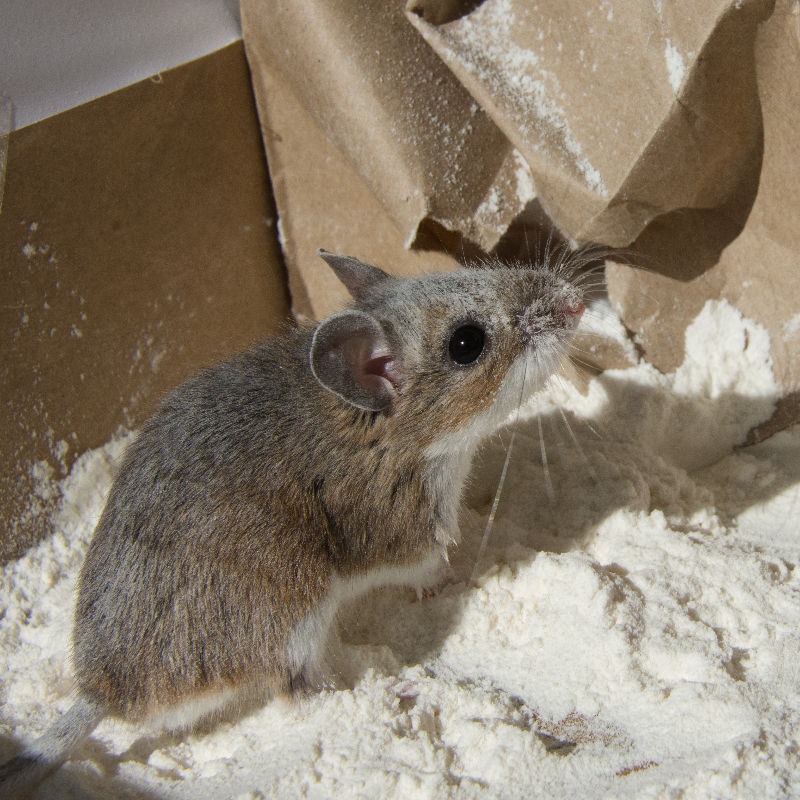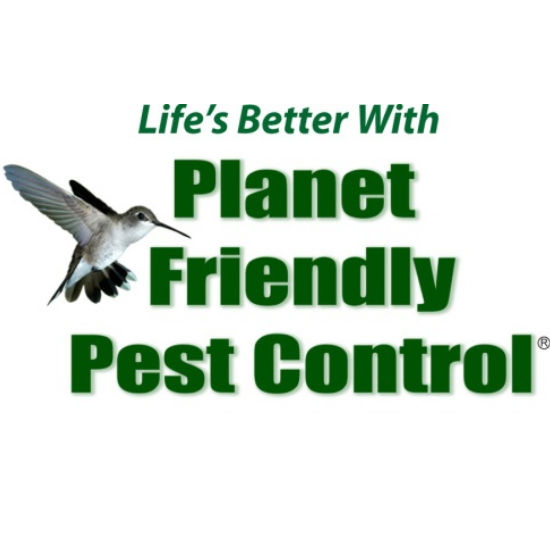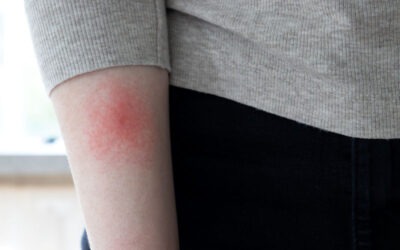
Serving All of Southern Maryland & Northern Virginia
Hear From Our
Happy Customers!
With over 250+ 5 star reviews, rest assured you’re in good hands with Planet Frienldy Pest Control
How to Get Rid of Mice
Transcript of Gene’s video about how to get rid of mice.
Hi. Gene, here. I would like to invite you to take a few minutes with me so we can talk about what I considered to be the most important pest control issue for you and your family and that is rodent control, specifically the white-footed mouse. And why this little guy, even though he might look cute, is much more dangerous than most of us think.
Meet Peromyscus leucopus, the white-footed mouse. The white-footed mouse is a native and very common in our area.
The female mouse can have babies beginning at 6 to 10 weeks of age and the gestation period for pregnancy is only around 22 days. Females can also breed with any available male including their own offspring. In short, one pregnant female can produce a lot of mice and left unchecked it can quickly turn into a serious problem.
You know, we don’t mind if mice live and stay away from the house, they’re actually very beneficial in some regards. They provide a food source for a lot of wild animals and they help move seeds of native plants. The problem is when they get close to our house and I’m talking, you know, from the foundation up to about 50 feet, they can be very problematic primarily in two areas.
One, they’re very destructive to property, both automobiles, vehicles, and your home. And number two, they transmit horrible diseases. ♪ [music] ♪Annually, rodents cause hundreds of thousands of dollars in property damage. Rodents can cause damage in many ways.
Their urine and feces can ruin personal items and it can totally contaminate the insulation in the walls and attic. Gnawing is another large problem. Rodent teeth never stop growing and because of this, mice are constantly chewing on everything. This need to constantly be gnawing becomes a real problem when rodents encounter human property.
Even though mice are destructive by nature, the number one risk to you and your family is the very real threat of disease. White-footed mice are the main source of transmitting Lyme disease to ticks. Those ticks then, in turn, bite us and infect us with Lyme disease.
The CDC says 75% of the people who will contract Lyme disease this year will get it around their home through being outside gardening, landscaping, children playing. The risk is very real and it makes a large difference when we can reduce the amount of rodents directly against the house.
We are not looking to create a sterile environment where there are no mice anywhere, our focus is very specific from the foundation out to about 50 feet. ♪ When we show up at your home to do a rodent and treatment, the very first thing we do is an inspection, we want to understand three things, access points, food sources and areas of habitat.
If we can solve or work on those things, we can go a long way to helping solve a problem without the use of trapping or other devices. For an interior rodent problem, some of our clients like to do their own trapping, others don’t, so we can work with you, show you how to set up a trapping program, we can do the trapping program for you. The bottom line is we will help you get the mice out of your house.
The main focus is on the exterior, we don’t want the mice to get in, to begin with. So the number one tool we use is the rodent bait station. Okay, this is the station we use, it’s animal proof and it’s childproof. It’s anchored with a 12-pound concrete block on the bottom.
You need a special key to get in. When we open it, the chambers contained within here is very specific. So it happens to access the bait, which is contained in this chamber here. The animal has to come in here or they can come in here and then they need to make a series of 90-degree turns.
So they come in, you have to make a 90-degree turn, 90-degree turn, and then another 90-degree turn to get into the bait chamber. So then the other point is these ridges right here on the edge and then on the lid are very specific because when this is closed, the ceiling to the pathway to get to the bait is very low.
These ridges shrink the ceiling. So the only animal that’s going to get in here is anything the size of the Norway rat or smaller. The bait is put on these metal rods. They get fed on, put in here. The animal comes in, they feed off of this. They cannot take the bait and drag it out, very effective. Remember, we are not trying to create a sterile environment where there’s no rodents anywhere out here in the environment, our focus is very specific, we don’t want mice or rodents against the foundation out to about 50 feet.
And correctly using bait stations can be very effective in accomplishing this. Is possible to do it yourself. If you’re not comfortable using rodenticides, it’s best to leave it to a professional. We have some information on our website, there’s tons of information on the internet.
Reducing rodent populations goes a long way to keeping you and your family safe and protected.
Don’t ignore the importance of keeping mice out of your home with a professional rodent control program. That pesky mouse is more dangerous than you think.
Our rodent control service includes a complete inspection of the property to assess the situation. We focus on eliminating or reducing food, access and habitat. We reduce mouse and rat populations around the exterior of the home by installing bait stations around the foundation. Most single-family homes require four stations that typically need service during the fall, winter and early spring. We will set up a mouse exterminator program for the interior of the home when needed.

While Lyme Disease is spread through a black-legged tick bite, the ticks must become infected themselves. The disease-causing Borrelia burgdorferi bacteria is what is needed in order to transmit Lyme. White-footed mice are one of the largest carriers of this bacteria “” and they’re among the animals that ticks feed off of the most. A professional rodent treatment will help reduce the spread of lyme infection in ticks.
Get rid of mice in your home today!
Rodent control is not something you want to delay. If you live in Southern Maryland ( Anne Arundel, St. Mary’s, Calvert or Charles County) or Northern Virginia ( Alexandria, Arlington, Annandale, McLean and more) act now.
Do you need a mouse exterminator?
Your home’s crawl spaces, basements, and attics provide the ideal habitat for these mice due to their lack of human activity and damp, dark environments. Squeaking noises within your walls and baseboards. If you spot mice droppings (they’re small, dark, and have pointy ends). If you smell something somewhat stale in a specific area of your home, you may have a mouse infestation. The same goes if your pets seem interested in a particular area. If you spot gnaw and scratch marks on walls and furniture, or if you spot mice tracks. Chewed up food packages, newspapers, and other small materials around your home are often signs that mice are building a nest. A good rodent control program will help keep you protected.
How to Get Rid of Mice in Your Home
How Reducing White-Footed Mice Populations in Fall & Winter Lowers Lyme Disease Risk
Reducing white-footed mice populations in the fall and winter can be a significant strategy in controlling Lyme disease risk. These rodents play a crucial role in transmitting Lyme disease to ticks, which can then infect humans. By implementing effective control...
Understanding Lyme Disease: The Role of White-Footed Mice and Black-Legged Ticks
Introduction to Lyme Disease Lyme disease is a tick-borne illness caused by the bacterium Borrelia burgdorferi, primarily transmitted to humans through the bite of infected black-legged ticks (Ixodes scapularis) in the northeastern, midwestern, and southeastern United...
The Complex Relationship Among White-Footed Mice, Borrelia burgdorferi, and Black-Legged Ticks in Lyme Disease Transmission
Lyme disease is a significant public health issue, particularly in areas where the disease-carrying bacterium Borrelia burgdorferi is prevalent. The cycle of transmission involves multiple species, but three primary players are crucial in the spread of Lyme disease:...
FAQs – Eco-Smart Rodent Control
1. Why is rodent control important for my home?
Rodent control protects your home from damage and health risks. Mice and rats can chew through wires, insulation, and personal items, and they are known carriers of diseases. A rodent control program safeguards your property and family.
2. How does Planet Friendly Pest Control address rodent issues?
We start with a comprehensive inspection to identify access points, food sources, and habitats attracting rodents. Exterior prevention includes tamper-resistant bait stations around your foundation. Interior treatments, such as trapping, eliminate existing infestations when necessary.
3. What are the costs associated with your rodent control services?
Our rodent control service includes four exterior bait stations for $250. Monthly maintenance during active seasons (fall to early spring) is $70. Interior assessments and treatments begin at $225, with additional fees for trapping if required.
4. Are your rodent control methods safe for my family and pets?
Yes, safety is our priority. Our tamper-resistant bait stations protect children and pets. We use eco-friendly products to minimize environmental impact, ensuring the safety of your home.
5. How do rodents contribute to the spread of Lyme disease?
Rodents like white-footed mice carry Borrelia burgdorferi, the bacteria causing Lyme disease. Infected ticks feeding on these mice can spread the disease to humans. Controlling rodents reduces the risk of infected ticks near your home.
6. What can I expect during the initial rodent control visit?
Our technicians conduct a detailed inspection of your property, identifying entry points, food sources, and nesting areas. Exterior bait stations are installed, and habitat modification recommendations are provided. Interior treatments are discussed if needed.
7. How often should rodent control services be performed?
Rodents are most active in fall, winter, and early spring. Monthly maintenance of bait stations during these seasons ensures effective prevention and long-term protection against infestations.
8. Can I perform rodent control on my own?
DIY methods may offer temporary relief but often fail to address root causes. Professional services provide comprehensive, long-lasting solutions with expertise in identifying and resolving infestations safely and effectively.
9. How do I schedule a rodent control service with Planet Friendly Pest Control?
Scheduling is easy. Visit our website to purchase services online, call us at 800-990-0335, or email service@planetfriendlypestcontrol.com to set up an appointment.
10. What areas do you serve for rodent control services?
We serve Southern Maryland (Anne Arundel, St. Mary’s, Calvert, Charles counties) and Northern Virginia (Alexandria, Arlington, Annandale, and nearby areas). Contact us to confirm service availability in your location.
11. How can I prevent mice from entering my home?
Mice need food, habitat, and access. Keep landscaping tidy and clear leaf debris near your home’s foundation. Store outdoor animal feed away from the house and seal potential entry points like gaps in siding, utility areas, or rooflines.
12. Why do mice eat bait off my traps but don’t get caught?
Mice adapt quickly to traps. To outsmart them, bait traps without arming them for a few days, allowing mice to feed without harm. Then arm only half the traps and rotate the armed traps over time for better results.
13. Why am I not catching mice even though I see droppings?
Two reasons: there may be better food sources than your trap bait, or your traps may not be in the right spots. Remove all food sources, store pet food in sealed containers, and place traps along edges or corners where mice travel.
14. Are rodenticide poisons safe?
Rodenticides can be effective but must be used responsibly. Consider factors like toxicity, potential secondary poisoning, and use in tamper-proof bait stations. If unsure, consult professionals to ensure safe and effective application.




